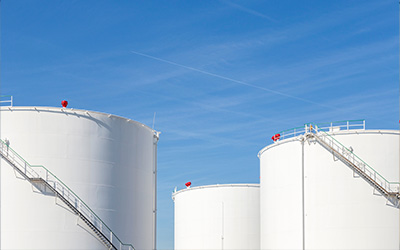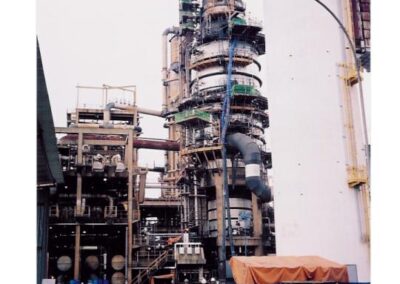Part 11
Vapor Phase Degreasing of Refinery Catalytic Reactors
Part 11, focusing on vapor phase degreasing of refinery catalytic reactors, in the series on how the chemical industry is solving challenges in the industrial sector. In a previous discussion about Hydrotreating, we talked about the types of fouling present in various parts of the hydrotreater. We did not address the catalytic reactor and cleaning of reactor internals of hydrocarbon liquids and heavier hydrocarbon deposits.
The hydrotreating process involves mixing hydrogen with sour hydrocarbon feed inside a reactor filled with cobalt/molybdenum (CoMo) or nickel/molybdenum (NiMo) catalysts. Using vapor phase degreasing to clean hydrocarbon deposits is effective.
In their active form, CoMo and NiMo catalyze the reactions that convert sulfur and nitrogen contaminants into H2S and NH3. These compounds are easily removed from the hydrogen off-gas stream in subsequent processing steps.
Hydrotreating catalysts are produced by coating extruded alumina with potentially active metals such as cobalt, nickel, molybdenum and tungsten. In the catalyst production process, the metals are deposited on the alumina substrate in their benign oxide form and must be converted to their respective sulfide before they will catalyze hydrodesulfurization (HDS) and hydrodenitification (HDN) reactions. This process is referred to as “pre-sulfiding” since the sulfiding process is carried out prior to resuming operation of the hydrotreating unit.
Fresh catalyst is usually hyper-active and feed to the hydrotreater is carefully selected at onset to avoid introduction of cracked stocks into the unit for a few days. This allows a layer of “soft coke” to form on the catalyst surface, tempering the hyper-activity associated with freshly sulfided catalysts. Fresh sulfided catalyst will quickly transform reactive olefinic compounds in the feed stocks into activity-harming coke and gums.
The feed stocks into the hydrotreater may contain unknown levels of common catalyst poisons such as silicon, arsenic, sodium, calcium, phosphorous and iron. Normal operating of the hydrotreater results in coke deactivation of the catalyst.
However, what usually determines the run length rather than coke deactivation, is contaminant deposition on the catalyst. This is the primary method of action for silicon. As silicon builds-up on the catalyst it begins to restrict the catalyst pores and eventually blocks access to the active site. This phenomenon is referred to as “pore mouth plugging”.
Arsenic is believed to react with the metal sulfide sites. Sodium is a severe catalyst poison promoting the sintering of catalytic metals and neutralizing the acid reactive sites. Calcium is a similar poison to sodium. Phosphorous will poison the active sites of the catalyst causing a loss of activity.
Iron works its way into hydrotreater feed as rust and iron scale from corrosion of upstream equipment and piping. Iron naphthenates can form from corrosion due to naphthenic acid in the feed, and the iron readily precipitates out in the presence of heat and H2S. These iron particulates fill the interstitial spaces in the catalyst bed which will result in a higher than expected pressure drop.
Why is vapor phase degreasing so important for catalyst reactors?
None of the above mentioned contaminates are removed during conventional chemical cleaning during a turnaround. These materials will be removed during catalyst regeneration. While the heavy metal poisons are addressed during catalyst regeneration, distribution trays and supports are usually soiled with gums, resins and heavy oil deposits. Cleaning of these organic contaminants can be accomplished through a vapor phase degreasing and cleaning process that does not introduce water into the reactor. It is important to avoid having water in contact with the reactor catalyst.
Hydrotreater catalysts are hygroscopic and will easily absorb 2-4% water when exposed to humid air or aqueous liquids. retained in the catalyst pore space will result in steam formation that will cause physical damage to the catalyst structure. This is commonly referred to as the “popcorn effect”, since rapid steam formation can fracture the catalyst in a process similar to the way popcorn is formed by heating.
Typically, the heavy oils can be removed by a process that introduces hot hydrogen into the reactor to vaporize the hydrocarbon liquids followed by replacement of the hydrogen with nitrogen. The nitrogen is cycled back through the equipment and a carefully selected non-aqueous, oil-soluble solvent is introduced into the nitrogen stream that can dissolve the heavier deposits and carry them out in vapor phase. The importance is the selection of the solvent cleaner that is non-flammable, low-boiling and will not damage the in-place catalyst.
This is a quick, effective process that is a spin-off of an old process known as vapor phase degreasing. It will remove the organic contaminants. While relatively a simple process, it is just a little complex due to the product selection.
Contact us to learn more about vapor phase degreasing for Hydrodesulfurization, Fluidized Catalytic Cracking Units, and Platformer applications. Let us show you how to improve your efficiency and financial performance.



